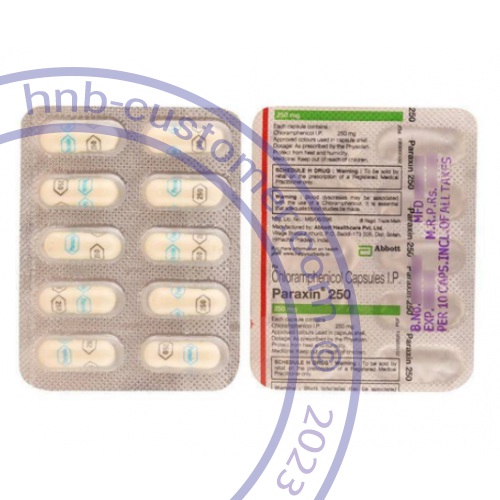Chloromycetin
Chloramphenicol
| Package | Per pill | Price | Savings | Order |
|---|---|---|---|---|
|
360 tablet
Free AirMail shipping
Hot
|
QAR 4.79
|
QAR 1724.76QAR 4.79
|
QAR 695.30
|
|
|
180 tablet
Free AirMail shipping
Hot
|
QAR 5.26
|
QAR 946.70QAR 5.26
|
QAR 263.33
|
|
|
120 tablet
Free AirMail shipping
Hot
|
QAR 5.63
|
QAR 675.11QAR 5.63
|
QAR 131.57
|
|
|
90 tablet
|
QAR 5.99
|
QAR 539.32QAR 5.99
|
QAR 65.69
|
|
|
60 tablet
|
QAR 6.36
|
QAR 381.51QAR 6.36
|
QAR 21.84
|
|
|
30 tablet
|
QAR 6.72
|
QAR 201.67QAR 6.72
|
|
Chloramphenicol capsule
What is this medicine?
CHLORAMPHENICOL is an antibiotic or antiinfective. It treats certain types of brain, lung, blood, or other serious infection.
What should my health care professional know before I take this medicine?
They need to know if you have any of these conditions:
- anemia or other blood disorders
- dental problems
- glucose 6-phosphate dehydrogenase (G6PD) deficiency
- liver disease
- kidney disease
- other chronic illness
- porphyria
- an unusual or allergic reaction to chloramphenicol, other antibiotics or preservatives
- pregnant or trying to get pregnant
- breast-feeding
How should I take this medicine?
Chloramphenicol capsules are taken by mouth. Take at regular intervals through the day and night (every 6 hours around the clock). Take the capsules with a full glass of water. Take 1 hour before or 2 hours after eating; taking it with food can make it less effective. Do not take your medicine more often than directed. Finish the full course of medicine prescribed by your prescriber or health care professional even if you feel better. Do not stop using except on your prescriber's advice.
Contact your pediatrician or health care professional regarding the use of this medicine in children. Special care may be needed.
Overdosage: If you think you have taken too much of this medicine contact a poison control center or emergency room at once.
NOTE: This medicine is only for you. Do not share this medicine with others.
What if I miss a dose?
If you miss a dose, take it as soon as you can. If it is almost time for your next dose, take only that dose. Do not take double or extra doses.
What may interact with this medicine?
- antibiotics
- B vitamins
- chlorpropamide
- doxercalciferol
- entacapone
- iron
- oral contraceptives (birth control pills)
- paricalcitol
- phenobarbital
- phenytoin
- ramelteon
- rifampin
- tolbutamide
- warfarin
Tell your prescriber or health care professional about all other medicines you are taking, including non-prescription medicines, nutritional supplements, or herbal products. Also tell your prescriber or health care professional if you are a frequent user of drinks with caffeine or alcohol, if you smoke, or if you use illegal drugs. These may affect the way your medicine works. Check with your health care professional before stopping or starting any of your medicines.
What should I watch for while taking this medicine?
Tell your prescriber or health care professional if your symptoms have not improved in a few days.
If you are taking this medicine for a long time you must visit your prescriber or health care professional for regular blood checks.
Chloramphenicol can cause blood problems. This can mean slow healing and a risk of infection. Problems can arise if you need dental work, or in the day to day care of your teeth. Try to avoid damage to your teeth and gums when you brush or floss your teeth.
If you are diabetic you may get a false-positive result for sugar in your urine. Check with your prescriber or health care professional before you change your diet or the dose of your diabetic medicine.
What side effects may I notice from this medicine?
Serious side effects include:
- unusual bleeding or bruising
- fever or chills, sore throat
- mouth sores
- unusual weakness or tiredness
- skin rash, itching
- confusion
- blurred vision
- gray syndrome (blue-gray skin color, low body temperature, uneven breathing, bloated stomach)
Call your prescriber or health care professional as soon as you can if you notice any of these side effects.
Children up to the age of 2 can develop "gray-baby" syndrome. Symptoms include refusal to eat, swollen stomach, paleness and a blue or gray skin color, limpness, and difficulty breathing. Death can result in just a few hours. If any of these symptoms occur, STOP GIVING THE MEDICATION AND SEEK MEDICAL HELP IMMEDIATELY.
Minor side effects include:
- headache
- nausea, vomiting
- diarrhea
This list may not describe all possible side effects.
Where can I keep my medicine?
Keep out of the reach of children in a container that small children cannot open.
Store at room temperature below 30 degrees C (86 degrees F). Protect from moisture. Throw away any unused medicine after the expiration date.











